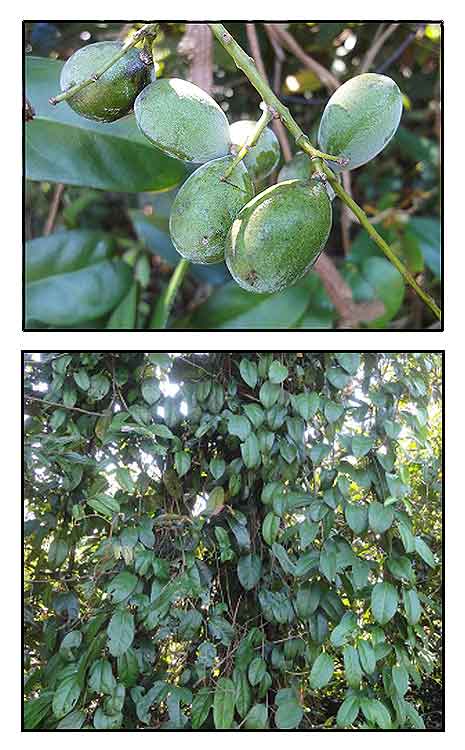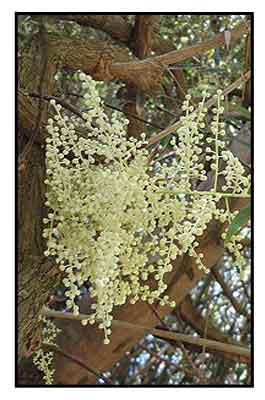 Gen info Gen info
- The genus Fibraurea Lour. consists of 2 species: F. tinctoria and F. recisa Pierre. F. recisa differs from F. tinctoria in having only 3 stamens and a thinner endocarp. It is confined to Cambodia, Vietnam and southern China. The species have sometimes been confused in the literature. However, they are used for the same purposes. Possible confusion of F. tinctoria with Arcangelisia flava (L.) Merr. has also been reported.
- Some compilations list Fibraurea darshanii Udayan & K.Ravik as a third species.
Botany
Fibraurea tinctoria is a large woody, dioecious, entirely glabrous climber, up to 40 m long and with stem diameter up to 5 cm; root spongy and flexile; young shoot-tips tendrilliform; bark of older stems greyish-buff, coarsely and irregularly striate. Leaves spirally arranged, thinly coriaceous, simple and entire, exstipulate, elliptic to ovate, 10-20(-28) cm × (3.5-)5-14 cm, rounded, sometimes subpeltate at base, acuminate at apex, 3(-5)-nerved; petiole (2-)4-13 cm long, often drying blackish at least at the swollen base. Flowers in axillary or ramiflorous lax panicles, with 6 whitish or yellowish inner sepals 2.5-4 mm long, and 2-3 minute outer ones, petals lacking; male flowers sweetly scented, with 6 stamens having very thick columnar filaments; female flowers with 3 ellipsoidal carpels and 6 rudimentary stamens. Fruit composed of up to 3 yellow or orange drupes borne on a small knob-like carpophore. (1)
Distribution
- Native to the Philippines.
- Also native to Assam, Borneo, Cambodia, India, Jawa, Laos, Malaya, Myanmar, Nicobar Is., Sulawesi, Sumatera, Thailand, Vietnam. (2)
- A climber growing primarily in the wet tropical biome. (2)
 Constituents Constituents
- Extracts of F. tinctoria yielded tannin, alkaloid, and saponin, with the ethanol extract showing higher composition than the water extract. Phenol composition of water-based extract was higher than the ethanol extract. (see study below) (3)
- Study of stems isolated five new furanoditerpenoids, epi-8-hydroxycolumbin (1), fibrauretin B (2), C (3), E (5), and F (6), as well as fibrauretin D (4) and 39 known compounds. (see study below)
(4)
- Study of stems isolated four new furanoditerpenoids, fibrauretin A (1), fibrauretinoside A (2), epi-fobrauretinoside A (3), and epi-12-palmatoside G (4), and a new ecdysteroid glucoside, fibraurecdyside A (5), together with seven known compounds including two furanoditerpenoids (6,7), an ecdysteroid (8), and four quaternary protoberberine alkaloids (9-12). (see study below)
(6)
- HPLC (High Performance Liquid Chromatography) showed the ethanol extract to contain 25.8% of berberine.
(8)
Properties
- Studies have suggested antibacterial, anti-inflammatory, antioxidant, cytochrome inhibitory, antimalarial, antiproliferative, anticancer, antidiabetic, acetylcholinesterase inhibitory properties.
Parts used
Leaves, aerial parts.
Uses
Folkloric
- No reported folkloric medicinal use in the Philippines.
- In Java, decoction of roots and stems used for treatment of dysentery, diabetes, and eye diseases. In Sarawak, used as stomach medicine.
(1)
- In Indonesia, used to soothe inflamed eyes, remove blood from feces, and treat headaches. In Malaysia, used to recover from childbirth, treat diabetes and nose ulcerations.
- In Kalimantan, Indonesia, plant used for treatment of headaches, diarrhea, diabetes, dysentery, malaria, lumbago and to increase stamina. (3)
- In Malaysia, sekunyit root and stem used to treat jaundice, diarrhea, conjunctivitis, and diabetes.
- In the Thai Nguyen province in Vietnam, used to treat stomach diseases, swelling and pain.
- In Borneo, used by healers to treat diseases caused by bacteria.
- Used to treat fever and constipation; used as tonic.
(18)
- In China, Huangteng roots and stems used for clearing away heat, detoxification, as diuretic and laxative. Also used to diet poisoning, heat depression, constipation, dysentery, infectious hepatitis, sore carbuncle, red eye, and sore throat.
(19)
Others
- Dye: Stem yields a yellow dye. In Kalimantan, used for dyeing mattings made from rattan and Curculigo species. Dye also used for coloring in India and Indo-China. Yellow dye sometimes mixed with indigo to prepare a green dye. (1)
- Wood: Wood is bright yellow.
Studies
• Antibacterial: Study evaluated the antibacterial activity of F. tinctoria. Stems, roots, and leaves were chopped, blended into smoothness, dried into powder extracted by ethanol and water into various concentrations from 0% to 10.0%. The 10% concentration showed highest activity against Staphylococcus aurea and Escherichia coli with S. aureus showing more susceptibility. (see constituents above) (3)
• Anti-Inflammatory / Furanoditerpenoids / Stems: Study of stems isolated five new furanoditerpenoids, epi-8-hydroxycolumbin (1), fibrauretin B (2), C (3), E (5), and F (6), as well as fibrauretin D (4) and 39 known compounds. All isolated furanoditerpenoids (1-16) were evaluated for anti-inflammatory activity. Compounds 8 and 9 showed significant anti-inflammatory activity at dose of 100 mg/kg reducing carrageenan mice paw edema. Compounds 7, 9, 10, 14, and 16 showed more potent NO production. Inhibitory effects were dose-dependent. (4)
• Antioxidant / Cytotoxicity / Stems: Stems of Arcangelisia flava, Coscinium blumeanum and Fibraurea tinctoria is collectively known in Thailand as Khaminkhruea. Twelve crude extracts of stems were assessed for antioxidant activity against DPPH radical and cytotoxic activity against brine shrimp and human cancer cell line MCF-7 (breast adenocarcinoma). Chloroform extract of F. tinctoria and other extracts showed pronounced cytotoxic activity against brine shrimp and MCF-7 cells with IC50s in range of 210-278 and 8-12 µg/ml, respectively. Chloroform extract of F. tinctoria yielded palmatine and jatrorrhizine as main alkaloids. (5)
• Cytochrome P3A4 Inhibitors / Stems: Study of stems isolated four new furanoditerpenoids (1-4), a new ecdysteroid glucoside (5), together with seven known compounds including two furanoditerpenoids (6,7), an ecdysteroid (8), and four quaternary protoberberine alkaloids (9-12). Among the compounds, palmatine (9) and jatrorrhizine (10) showed inhibitory effects against cytochrome P450 3A4 (CYP3A4) with IC50s of 0.9 and 2.1 µM, respectively. (see constituents above) (6)
• Antimalarial: Study in Vietnam evaluated 228 extracts from 49 plants for in vitro activity against Plasmodium flaciparum. Fibraurea tinctoria was one of six plants that showed interesting antiplasmodial activity with IC50s ranging from 0.4 to 8.6 µg/ml with good selectivity. (7)
• Antiproliferative / Colon Cancer: Study evaluated the antiproliferative and apoptotic activities of methanolic extracts and fractions of 23 selected plants on human colon cancer cell line (HT-29) by sulforhodamine B assay. Methanol extract of Fibraurea tinctoria was one of five plants that showed potent anti-proliferative activity. After liquid-liquid partition, the methanol-water fraction of F. tinctoria showed higher anti-proliferative activity than the methanol extract and demonstrated high cancer cell selectivity. (9)
• Antimalarial/ Plasmodium berghei / Stem: Study evaluated the in vivo antimalarial effect of yellow root stem against Plasmodium berghei in inoculated mice. There were significant difference at therapy group with 10 mg/g BW extract combined with artemisinin, 1 mg/g BW extract combined with artemisinin, and only artemisinin against reduction degree of parasitaemia at p<0.05. Results showed treatment with methanol extract of yellow root combined with artemisinin showed in vivo antimalarial activity. (10)
• Anticancer / DLD1 Colon Cancer Cell Line: Study evaluated the cytotoxic effects of Fibraurea tinctoria on DLD1 colon cancer cell lines in vitro and determined the IC50s. Among methanol extract, hexane fraction, ethyl acetate fraction and HA and HB subfractions, only the HB subfraction showed inhibitory activity against DLD1 colon cancer cell line with 28% at 1600 ppm concentration. (11)
• Antidiabetic: Study evaluated the effects of oral administration of akar kuning (F. tinctoria Lour) ethanol extract in alloxan-induced diabetic rats. Glibenclamide was used was reference drug. Results showed the ethanol extract exhibited antidiabetic effects (p<0.05) at doses of 50, 100, and 200 mg/kbw. The dose of 100 mg/kbw was most effective in lowering blood glucose levels. (12)
• Antiplasmodial / Malate Quinone Oxidoreductase Inhibitor: Study evaluated a compound from Fibraurea tinctoria known to have antiplasmodial activity from the berberine compound. Lactase dehydrogenase (LDH) assay and malate quinone oxidoreductase (pfMQO) inhibitor assay against Plasmodium falciparum was used. Results showed the methanol extract, n-hexane fraction, n-hexane subfraction and steroid compounds isolated from the n-hexane fraction had potential ability to inhibit the growth of P. falciparum 3D7 as well as the pfMQO enzyme. Results suggest a promising medicinal plant for future antimalarial development. (13)
• Antidiabetic / Roots and Stems: Study evaluated the antidiabetic activity of ethanol extract of roots and stem of sekunyit on alloxan induced diabetic white male mice (Mus musculus L) using glibenclamide as control. Results showed significant lowering of blood glucose levels (p<0.05) of diabetic mice, decreased urine volume (p<0.05), decreased volume of drinking water (p<0.05), with no effect of relative organ weight of heart, liver, and kidney (p>0.05). (14)
• Antibacterial against Shigella dysenteriae and Salmonella typhi: Study evaluated the difference in antibacterial potency of infusion of akar kuning against growth of S. dysenteriae and S. typhi. Ciprofloxacin was used as positive control. Results showed the higher the concentration of the infusion, the larger the inhibition zone. There was no statistical difference in antibacterial potency of the infusion. At 64% concentration, inhibition zone for S. typhi was 16.32 mm compared to S. dysenteriae at 15.50 mm. (15)
• Palmatine on Oral Squamous Cell Carcinoma / PaH-PDT Therapy: Oral squamous carcinoma (OSCC) accounts for about 7% of all malignant tumors. Palmatine hydrochloride (PaH) is an alkaloid constituent of Fibraurea tinctoria. Study investigated the antitumor effect of photodynamic therapy (PDT) with PaH (PaH-PDT) on human OSCC cell lines in vitro and in vivo. Results showed PaH-PDT exhibited potent phototoxic effect in cell proliferation and produced cell apoptosis. It increased the percentage of cells in the G0/G1 phase and decreased CDK2 and Cyclin E1 protein level, and markedly increased the generation of intracellular ROS, and increased expression of p53 protein in vitro and in vivo. In vivo experiments showed effective inhibition of tumor growth and prolonged survival time of tumor-bearing mice. No side effects or weight loss was observed. Results suggest PaH is a promising sensitizer that can be combined with light to produce significant anti-tumor effects in OSCC via enhanced ROS production and up-regulated expression of p53. (16)
• Acetylcholinesterase Inhibitory Activity / Alzheimer Treatment: Study evaluated 40 medicinal plant extracts of Bay Nui region, An Giang province, for acetylcholinesterase inhibitory activity. Thirteen extracts showed IC50 values below 100 µg/mL. Four MeOH extracts exhibited strongest acetyl-cholinesterase inhibitory activity, with Fibraurea tinctoria showing lowest IC50 of 0.36, compared to positive control, galantamine with IC50 of 0.73 µg/mL and berberine at 0.27 µg/mL. (17)
Availability
Wild-crafted.
|

![]()





